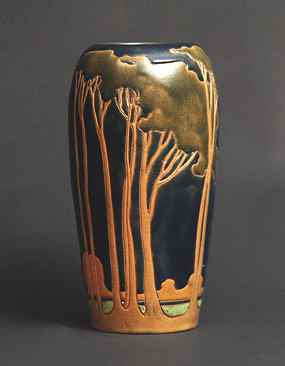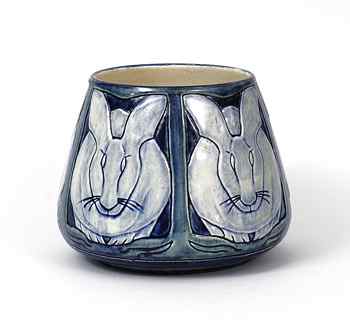 2009, is a major and illuminating ceramics exhibition.
(right: Vase with Landscape (about 1914-1917), Glazed orange-red
terra-cotta earthenware, Designed and executed by Frederick Hurten Rhead.
©Two Red Roses Foundation)
2009, is a major and illuminating ceramics exhibition.
(right: Vase with Landscape (about 1914-1917), Glazed orange-red
terra-cotta earthenware, Designed and executed by Frederick Hurten Rhead.
©Two Red Roses Foundation)Editor's note: The Museum of Fine Arts, St. Petersburg, FL provided source material to Resource Library for the following article or essay. If you have questions or comments regarding the source material, please contact the Museum of Fine Arts directly through either this phone number or web address:
Beauty in Common Things: American Arts and Crafts Pottery from the Two Red Roses Foundation
October 4, 2008 - February 15, 2009
Beauty in Common
Things: American Arts and Crafts Pottery from the Two Red Roses Foundation, on view from October 4, 2008 through February 15,  2009, is a major and illuminating ceramics exhibition.
(right: Vase with Landscape (about 1914-1917), Glazed orange-red
terra-cotta earthenware, Designed and executed by Frederick Hurten Rhead.
©Two Red Roses Foundation)
2009, is a major and illuminating ceramics exhibition.
(right: Vase with Landscape (about 1914-1917), Glazed orange-red
terra-cotta earthenware, Designed and executed by Frederick Hurten Rhead.
©Two Red Roses Foundation)
The show features approximately 80 superb examples of pottery from the American Arts and Crafts movement by such esteemed potteries as Rookwood, Grueby, Newcomb College, Marblehead, Teco, Saturday Evening Girls, and Overbeck. Furniture and paintings will place the ceramic objects in context and create environments that will enhance understanding of the Arts and Crafts movement in America. The St. Petersburg Times is the media sponsor.
The quiet strength and dignity of the mat-glazed Grueby vases is matched by the richly grained oak furniture of Gustav Stickley. The gentle color combinations and Japanese-inspired decoration on the work of the Marblehead Potteries find their counterpoint in the exquisitely painted furniture of the Byrdcliffe Colony. All the works are on loan from the Two Red Roses Foundation, one of this country's most important private collections of Arts and Crafts objects.
Reacting against the crassness of industrial production and seeking to elevate the decorative arts to the level of the fine arts, fervent Arts and Crafts reformers advocated the reintegration of art into everyday life. The implications were both social and aesthetic and touched upon critical issues such as the role of women in society and the search for a modern style. This exhibition is curated by Dr. Martin Eidelberg, Professor Emeritus of Art History at Rutgers University, and Dr. Jonathan Clancy of the Sotheby's Institute of Art.
Museum Director Dr. John Schloder writes in the introduction to the catalogue that "this exhibition and its accompanying catalogue explore the ceramics of this transformative, turn-of-the-century movement. Most of the great ceramic producers are represented with artful works that people lovingly used in their homes and in their everyday life and, increasingly nowadays, collect for their own aesthetic pleasure."
The collection was developed by Rudy Ciccarello of Florida. After seeing and admiring a reproduction of an early 1900s bookcase made by Gustav Stickley, he soon became immersed in studying the American Arts and Crafts movement. He has written: "I grew to appreciate the historical importance of the movement, the craftsmen, and the wonderful pieces of art they produced -- I was hooked."
His private collection, slightly more than 10 years in
the making, eventually grew too much for his home, and he had to begin storing
the objects in a  warehouse. This
inspired the formation of the Two Red Roses Foundation, which is designed
to increase awareness of the Arts and Crafts movement nationally, in part
through exhibitions. In addition to pottery, the holdings encompass furniture,
ceramic tiles, woodblock prints, metalwork, lighting, and paintings. (left:
Newcomb College Pottery, Bowl with Rabbits (1902), Glazed earthenware,
Designed and executed by Marie de Hoa Le Blanc, potted by Joseph Fortune
Meyer. ©Two Red Roses Foundation)
warehouse. This
inspired the formation of the Two Red Roses Foundation, which is designed
to increase awareness of the Arts and Crafts movement nationally, in part
through exhibitions. In addition to pottery, the holdings encompass furniture,
ceramic tiles, woodblock prints, metalwork, lighting, and paintings. (left:
Newcomb College Pottery, Bowl with Rabbits (1902), Glazed earthenware,
Designed and executed by Marie de Hoa Le Blanc, potted by Joseph Fortune
Meyer. ©Two Red Roses Foundation)
Beauty in Common Things continues a Museum tradition of displaying the finest ceramics from around the world. But this represents the first substantial exhibition of American Arts and Crafts pottery at the MFA -- work that continues to influence ceramic artists today.
Catalogue
In their catalogue essay, Dr. Eidelberg and Dr. Clancy explore the ideals of the Arts and Crafts movement and how these goals played out in the creation of actual objects-in material culture. There was a reaction, for example, against the effects of industrialization and a call for individual creativity. But the curators note that "the tension between handmade and serial production remained one of the fundamental and insolvable problems within the Arts and Crafts movement. Reform theory praised handwork as of supreme importance, but the reality of the modern economic world showed great accommodations."
Arts and Crafts pottery developed partly in response to British theorists, but over time assumed a more distinctly American character. By the turn of the century, the objects were mostly marked by restraint and simpler forms and an overall sense of harmony. They were not "busy" with ornamentation.
In the exhibition and catalogue, the curators examine the new view of the beneficial values of work advanced by the Arts and Crafts theorists and practitioners. Handicraft, it was argued, offered an alternative to mind-numbing and exploitative factory jobs. By encouraging the contributions of the individual craftsman in a more humane setting, work was made joyful and liberating.
This was both a social and aesthetic movement, and the debate over the dignity of the worker and the quality of the workplace is still with us today. Many aspects of the Arts and Crafts movement strike us today as very modern. Just think of the spare forms that were to characterize so much of modern art and design.
The catalogue, available in the Museum Store, documents all of the works exhibited and sheds new light on the origin and meaning of "Arts and Crafts." It is written by two of the leading experts in the field.
About Dr. Martin P. Eidelberg and the The Wayne W. and Frances Knight Parrish Lecture, October 5, 2008
On October 5, 2008, distinguished scholar Dr. Martin P. Eidelberg discussed "Art and Crafts Pottery, What's in a Name?" Along with Dr. Jonathan Clancy, he curated Beauty in Common Things.
Dr. Eidelberg, Professor Emeritus of Art History at Rutgers University, is one of the world's foremost scholars of modern decorative arts. He was one of the curators of the groundbreaking 1972 exhibition, The Arts and Crafts Movement in America, 1876-1916, which sparked greater interest in turn-of-the-century decorative arts. Since then, he has published extensively on various American potteries such as Grueby and Robineau, as well as seminal essays in the field.
One of the leading scholars on Louis C. Tiffany, Dr. Eidelberg has written or contributed to several important books on the subject: Masterworks of Louis Comfort Tiffany (1989), Behind the Scenes of Tiffany Glassmaking: The Nash Notebooks (2001), and The Lamps of Louis Comfort Tiffany (2005).
In 2007, Dr. Eidelberg was one of three curators of A New Light on Tiffany: Clara Driscoll and the Tiffany Girls at the New York Historical Society. This pioneering exhibition and catalogue revealed that Driscoll designed most of Tiffany's leaded-glass lamps and many of his objets d'art. However, she worked anonymously like most of Tiffany's collaborators. His most recent publication in this area is Tiffany Favrile Glass and the Quest of Beauty (2007), the only in-depth study of this famous American's beautiful glass vases.
Dr. Eidelberg has also published and lectured widely on European Art Nouveau, on Edward Colonna who worked for S. Bing's L'Art Nouveau gallery in Paris, and the ceramists Edmond Lachenal and Clément Massier. Moving to a more contemporary period, he has focused on post-war design. In collaboration with the Montreal Museum of Decorative Arts, he brought forth the prize-winning Design 1935-1965: What Modern Was, and studies on post-war ceramics, furniture, and American studio jewelry. Most recently, he contributed to a monograph on The Eames Lounge Chair: An Icon of Modern Design.
This noted scholar has yet another, totally unrelated field: French eighteenth-century drawing and painting with particular emphasis on Antoine Watteau and the Rococo.
Beginning at Rutgers in 1964, Dr. Eidelberg retired as Professor Emeritus in 2002. He was named "Outstanding Teacher of the Year" in 1994. He earned his B.A. cum laude from Columbia University, where he was named to Phi Beta Kappa, and his Ph.D. from Princeton.
Each year the Parrish Lecture brings an outstanding speaker
to the Museum. The Parrishes, who lived most of their lives in Washington,
D.C., donated many of the Museum's most significant pre-Columbian objects.
They are displayed in the Parrish Gallery. Mr. Parrish was a successful
publisher of aviation magazines, and Mrs. Parrish was a noted public servant.
She was director of the U.S. Passport Office from 1955-1977. Funds from
The Parrish Estate make this lecture series possible.
Editor's note: RL readers may also enjoy:
Read more articles and essays concerning this institutional source by visiting the sub-index page for the Museum of Fine Arts, St. Petersburg in Resource Library.
Search Resource Library for thousands of articles and essays on American art.
Copyright 2008 Traditional Fine Arts Organization, Inc., an Arizona nonprofit corporation. All rights reserved.